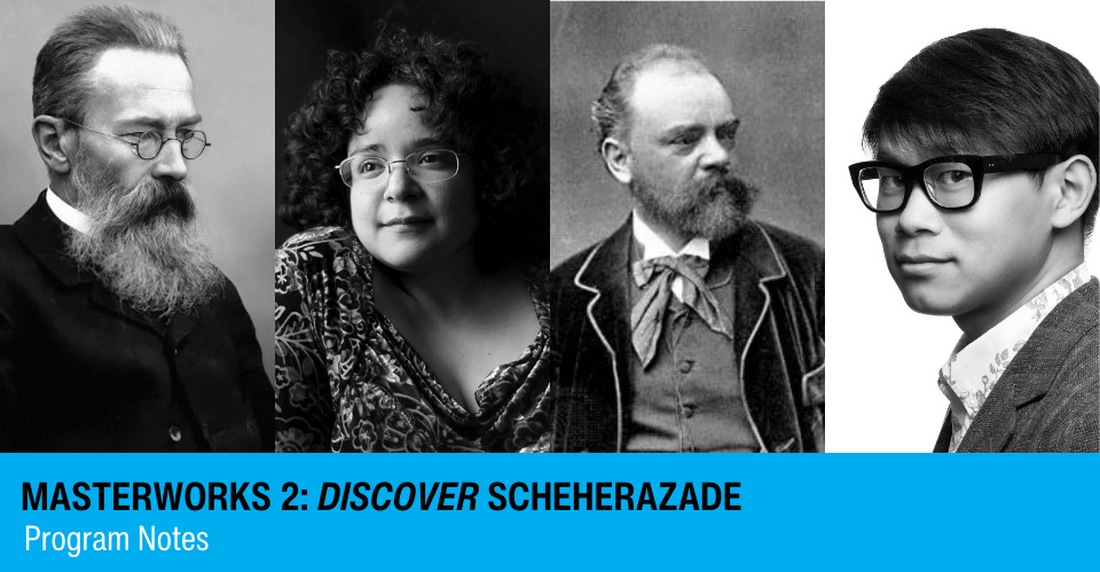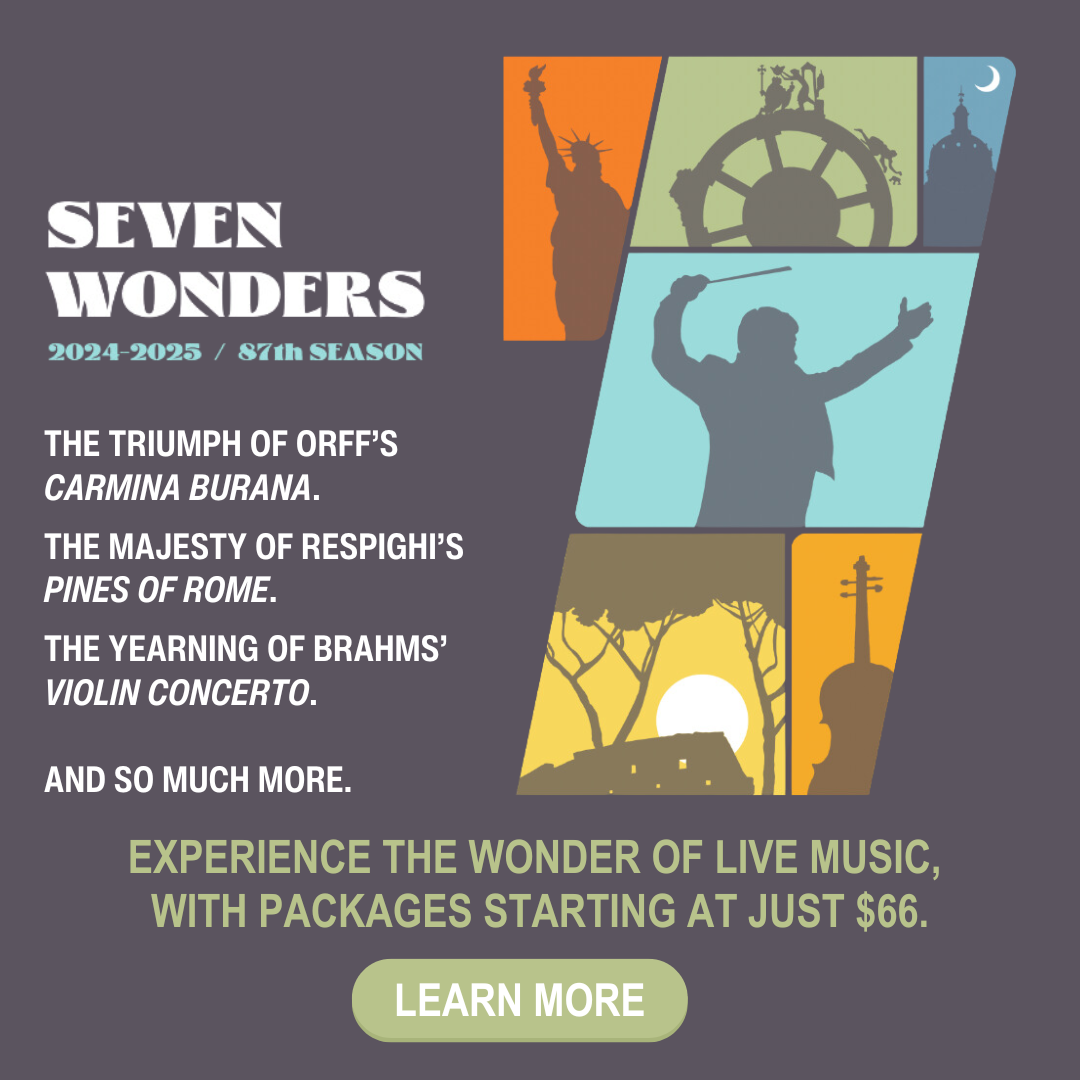30 SECOND NOTES: A world of sonorities is encompassed by this Des Moines Symphony concert. The brilliance, power and virtuosity of the Romantic symphony orchestra are featured in Carnival Overture by Antonín Dvořák, which he said evokes a “wanderer reaching at twilight a city where a festival is in full swing,” and Nikolai Rimsky-Korsakov’s Scheherazade, inspired by the exotic tales comprising The Thousand and One Nights. The enormous expressive range of the percussion instruments is exploited in the driving Latin rhythms of Escaramuza (“Skirmish”) by the “Peruvian-Chinese-Jewish-Lithuanian” (her description) composer Gabriela Lena Frank and the widely varied sounds of the concerto Re(new)al by Viet Cuong, the son of Vietnamese immigrants.
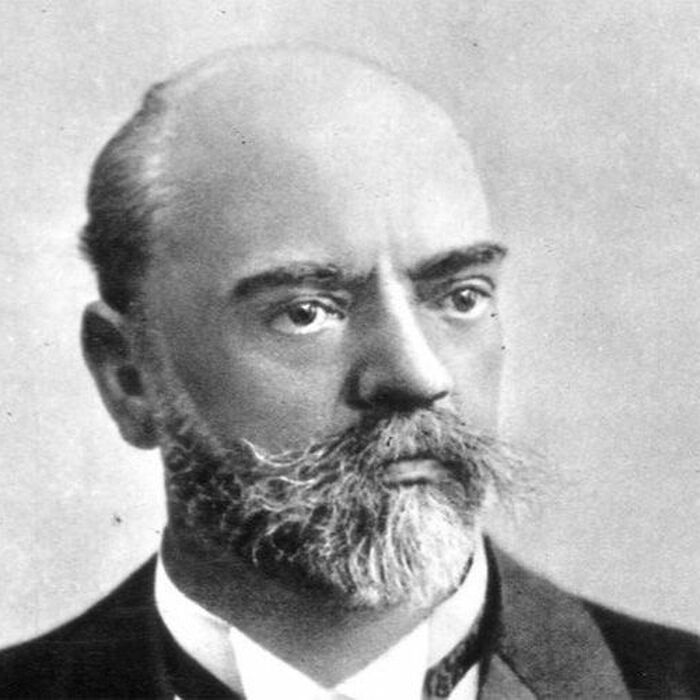
Antonín Dvořák
- Born September 8, 1841 in Nelahozeves, Bohemia (now Czech Republic)
- Died May 1, 1904 in Prague
CARNIVAL OVERTURE, OP. 92
- First performed on April 28, 1892 in Prague, conducted by the composer.
- First performed by the Des Moines Symphony on May 6, 1951 with Frank Noyes conducting. Six subsequent performances occurred, most recently on September 25 & 26, 2010 with Joseph Giunta conducting.
(Duration: ca. 9 minutes)
Like almost every musician of the late 19th century, Dvořák had to come to grips with the astounding phenomenon of Richard Wagner and his music dramas. Around 1890, he undertook a study of this grandiloquent music, as well as that of Wagner’s stylistic ally (and father-in-law) Franz Liszt, and he was rewarded with a heightened awareness of the expressive possibilities of orchestral program music. Several important scores from Dvořák’s last years seem to bear the influence of his study of this so-called “Music of the Future”: the five tone poems of 1896-1897 (The Water Goblin, The Noon Witch, The Golden Spinning Wheel, The Wild Dove and Heroic Song), Silent Woods for Cello and Orchestra, Poetic Tone Pictures for Solo Piano, and the 1892 cycle of three concert overtures: InNature’s Realm, Carnival and Othello.
In his study of the composer, John Clapham indicated that Dvořák intended the triptych of overtures to represent “three aspects of the life-force’s manifestations, a force which the composer designated ‘Nature,’ and which not only served to create and sustain life, but also, in its negative phase, could destroy it.” More specifically, Otakar Šourek noted that they depicted “the solemn silence of a summer night, a gay whirl of life and living, and the passion of great love.” Dvořák himself said that the Carnival Overture was meant to depict “a lonely, contemplative wanderer reaching at twilight a city where a festival is in full swing. On every side is heard the clangor of instruments, mingled with shouts of joy and the unrestrained hilarity of the people giving vent to their feelings in songs and dances.” Dvořák evoked this scene with brilliant music given in the most rousing sonorities of the orchestra. Into the basic sonata plan of the piece, he inserted, at the beginning of the development section, a haunting and wistful paragraph led by the English horn and flute to portray, he said, “a pair of straying lovers,” the wanderer apparently having found a companion. Following this tender, contrasting episode, the festive music returns and mounts to a spirited coda to conclude this joyous, evergreen Overture.
The score calls for piccolo, flutes, clarinets, oboes, and bassoons in pairs, English horn, four horns, two trumpets, two trombones, tuba, timpani, cymbals, tambourine, triangle, harp and the usual strings consisting of first violins, second violins, violas, violoncellos and double basses.
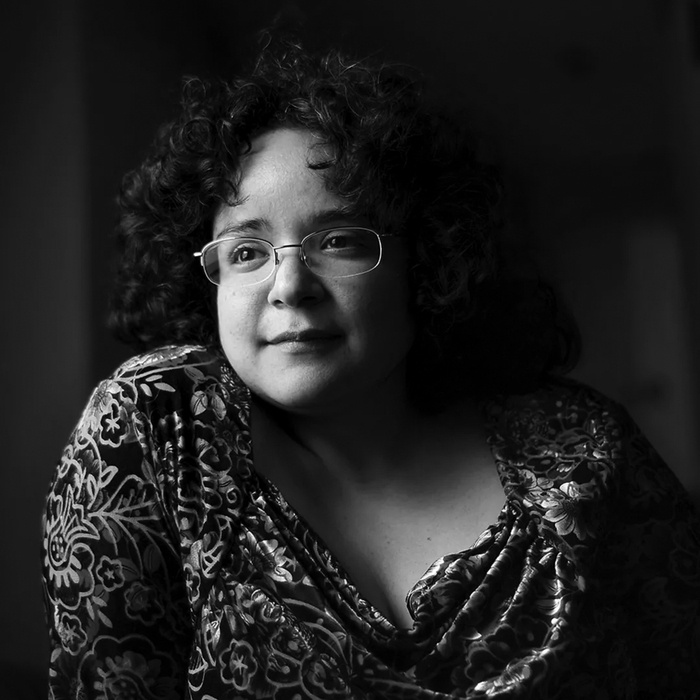
Gabriela Lena Frank
- Born September 26, 1972 in Berkeley, California.
ESCARAMUZA (“SKIRMISH”)
- First performed on September 11, 2010 by the Huntsville (Alabama) Symphony Orchestra, conducted by Carlos Miguel Prieto.
- These concerts mark the first performances of this piece by the Des Moines Symphony.
(Duration: ca. 9 minutes)
The fact that Gabriela Lena Frank was born in 1972 in Berkeley, California of Peruvian heritage forms the basis of her creative personality, which draws together musical qualities from both North and Latin America. Frank, gifted as a composer, pianist and speaker, earned her Bachelor’s and Master’s degrees at Rice University in Houston and her Doctorate at the University of Michigan; her principal teachers have included William Albright, Leslie Bassett, William Bolcom and Samuel Jones in composition, and Jeanne Kierman Fischer and Logan Skelton in piano. As a pianist, Frank has recorded the complete solo piano and violin/piano compositions of her teacher, Pulitzer Prize-winning composer Leslie Bassett. Frank said of her improbable career, “I firmly believe that only in the United States could a Peruvian-Chinese-Jewish-Lithuanian girl born with significant hearing loss in a hippie town successfully create a life writing string quartets and symphonies.”
Frank’s compositions incorporate elements of Latino/Latin American mythology, archeology, art, poetry and folk music into traditional Classical forms in works for orchestra, chamber ensembles, piano, chorus and vocal solo. In addition to the inaugural Sackler Music Composition Prize of the University of Connecticut in 2002, Frank has received many commissions, grants and awards and held residencies with orchestras, schools and festivals in North America and throughout Latin America; she was Composer-in-Residence with the Philadelphia Orchestra in 2021-2022. Since 2010, she has taught at the Cortona Sessions for New Music in Italy. Frank received the 2009 Latin Grammy Award for Best Classical Music Composition (Inca Dances) and a Grammy nomination for Best Classical Crossover Album as one of the composers who contributed to Yo-Yo Ma’s Silk Road Ensemble 2011 CD, Off the Map. In 2017, she founded the Gabriela Lena Frank Creative Academy of Music, a non-profit training institution that offers emerging composers short-term retreats at her farms in California, and was included in the Washington Post’s list of the “35 Most Significant Women Composers in History.” Frank also served as the keynote speaker at the national convention of the Association of Late-Deafened Adults in September 2005 in Salt Lake City. San Diego Opera premiered Frank’s first opera, The Last Dream of Frida and Diego, with a libretto by Pulitzer Prize-winning playwright Nilo Cruz, in October 2022.
Frank wrote that Escaramuza (“skirmish” in Spanish), composed in 2010 for the Huntsville Symphony Orchestra, “was inspired by the kachampa music of Andean Perú. Celebrating the pre-Hispanic Inca warrior, the kachampa dance is executed by athletic men who convey a triumphant, even joyful, spirit. Inspired by the kachampa dances done with fast-snapping ropes that I’ve witnessed in Perú, especially in Paucartambo during the Virgen de la Carmen Festival, I’ve created a brightly chiseled romp in an asymmetrical 7/8 rhythm that is launched after an extended bass drum solo. Throughout most of Escaramuza, no section of the ensemble is allowed to rest for long, maintaining the high energy typical of kachampas.”
The score calls for timpani, snare drum, bass drum, cymbals, rototoms, tambourine, triangles, castanets, claves, whip, button gong, marimbas, piano, harp and the usual strings.
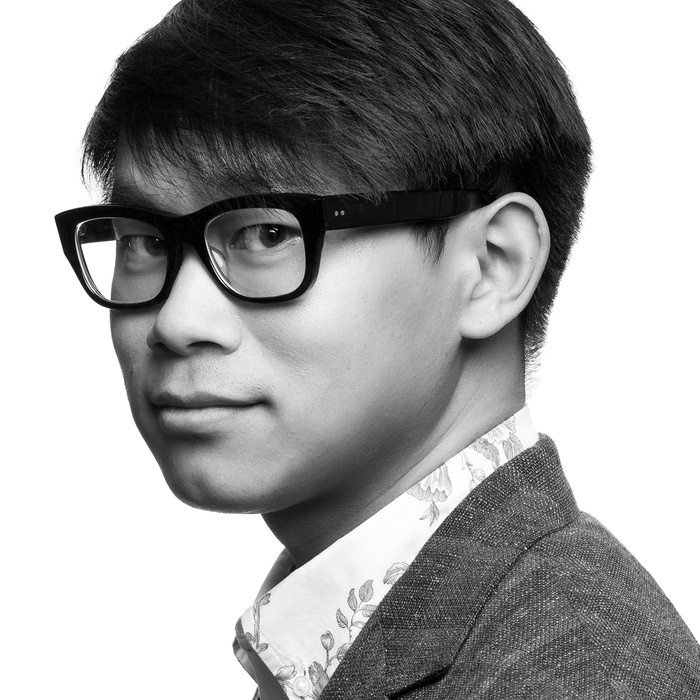
Viet Cuong
- Born September 8, 1990 in West Hills, California.
RE(NEW)AL, CONCERTO FOR PERCUSSION QUARTET & ORCHESTRA
- First performed on October 13, 2018 by the Albany Symphony Orchestra (New York), conducted by David Alan Miller with Sandbox Percussion as soloists.
- These concerts mark the first performances of this piece by the Des Moines Symphony.
(Duration: ca. 16 minutes)
Viet Cuong, the son of Vietnamese immigrants, was born in 1990 in West Hills, California, north of Malibu, but grew up in Marietta, Georgia, where the school music program gave him both a love of music and a sense of belonging. He studied composition at the Peabody Institute, Princeton University and Curtis Institute of Music with eminent teaching composers Jennifer Higdon, Kevin Puts, Steven Mackey, Jennifer Higdon, David Serkin Ludwig and Richard Danielpour, and received additional training at the Orchestra of St. Luke’s DeGaetano Institute, Minnesota Orchestra Composers Institute, Mizzou International Composers Festival, Eighth Blackbird Creative Lab, Cabrillo Festival’s Young Composer Workshop, Cortona Sessions, Copland House’s CULTIVATE workshop, and Aspen and Bowdoin Music Festivals. Cuong is now Assistant Professor of Composition at the University of Nevada, Las Vegas and Young American Composer-in-Residence with the California Symphony, for whom he has been commissioned to compose three new works. He previously held artist residencies at the Pacific Symphony, Yaddo, Ucross, Atlantic Center for the Arts and Dumbarton Oaks, where he served as the Early-Career Musician-in-Residence. Cuong’s eclectic compositions, which draw inspiration from and even incorporate everyday sounds and objects — a snare drum played with a hair comb and a credit card; Re(new)al opens with a quartet of tuned crystal wine glasses — have been performed internationally by such diverse ensembles as the New York Philharmonic, Alarm Will Sound, Sō Percussion, United States Navy Band and PRISM Saxophone Quartet. Among Cuong’s growing list of honors are the Frederick Fennell Prize, Walter Beeler Memorial Prize, Barlow Endowment Commission, ASCAP Morton Gould Composers Award, Theodore Presser Foundation Award, Cortona Prize, New York Youth Symphony First Music Commission, and Boston GuitarFest Composition Prize.
Viet Cuong wrote, “Re(new)al was originally composed with chamber orchestra accompaniment on commission by conductor David Alan Miller and the Albany Symphony’s Dogs of Desire, in partnership with GE Renewable, for the 2017 American Music Festival. The full orchestra version was commissioned in 2018 by the Albany Symphony; a version for wind ensemble was commissioned by a consortium of universities and community ensembles.
“I have tremendous respect for renewable energy initiatives and the commitment to creating a new, better reality for us all. Re(new)al is a percussion quartet concerto that is similarly devoted to finding unexpected ways to breathe new life into traditional ideas, and the solo quartet therefore performs on several ‘found’ instruments. While the piece also features more traditional instruments, such as snare drum and vibraphone, I looked for ways to either alter their sounds or find new ways to play them. For instance, certain notes of the vibraphone are prepared with aluminum foil to recreate sounds found in electronic music. The entire piece was conceived this way, and it was a blast to discover all of these unique sounds with the members of Sandbox Percussion.
“Cooperation and synergy are also core themes of the piece, as I believe we all have to work together to move forward. All of the music played by the solo quartet comprises single musical ideas that are evenly distributed among the four soloists. The music would therefore be dysfunctional without the presence and dedication of all four members.
“Re(new)al is in three continuous movements, each inspired by the power of hydro, wind and solar energies. The Hydro movement transforms tuned crystal glasses into ringing hand bells as the ensemble slowly submerges the soloists in their sound. The second movement (Wind) turns each member of the quartet into a blade of a dizzying wind turbine, playing seemingly impossible 1990’s-inspired drum and bass patterns. The closing movement (Solar) simulates a sunrise and evokes the brilliance of sunlight with metallic percussion instruments.”
The score calls for flutes, clarinets, oboes, and bassoons in pairs, four horns, two trumpets, three trombones, tuba, timpani, xylophone, vibraphone, two marimbas, crotales, triangle, crash cymbals, suspended cymbal, whip, bass drum and the usual strings.
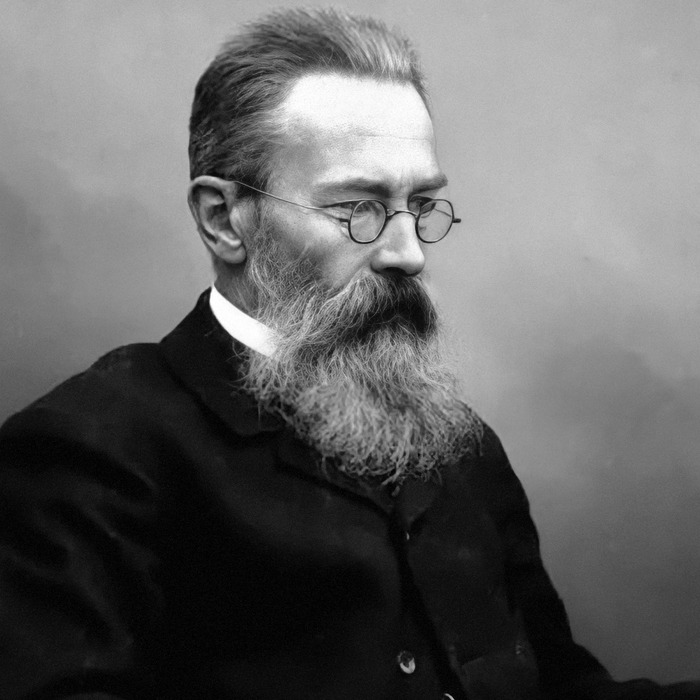
Nikolai Rimsky-Korsakov
- Born March 18, 1844 in Tikhvin, near Novgorod
- Died June 21, 1908 in St. Petersburg
SCHEHERAZADE, OP. 35
- First performed on December 15, 1888 in St. Petersburg, conducted by the composer.
- First performed by the Des Moines Symphony on December 6, 1973 with Henry Charles Smith conducting. Seven subsequent performances occurred, most recently on October 12 & 13, 2019 with Joseph Giunta conducting.
(Duration: ca. 45 minutes)
“In the middle of the winter [of 1888], engrossed as I was in my work on Prince Igor and other things, I conceived the idea of writing an orchestral composition on the subject of certain episodes from Scheherazade.” Thus did Nikolai Rimsky-Korsakov give a curt explanation of the genesis of his most famous work in his autobiography, My Musical Life. His friend Alexander Borodin had died the year before, leaving his magnum opus, the opera Prince Igor, in a state of unfinished disarray. Rimsky-Korsakov had taken it upon himself to complete the piece, and may well have been inspired by its exotic setting among the Tartar tribes in 12th-century central Asia to undertake his own embodiment of musical Orientalism. The stories on which he based his orchestral work were taken from The Thousand and One Nights, a collection of millennium-old fantasy tales from Egypt, Persia and India which had been gathered together, translated into French, and published in many installments by Antoine Galland beginning in 1704.
To refresh the listener’s memory of the ancient legends, Rimsky-Korsakov prefaced the score with these words: “The sultan Shakriar, convinced of the falsehood and inconstancy of all women, had sworn an oath to put to death each of his wives after the first night. However, the sultana Scheherazade saved her life by arousing his interest in the tales she told him during 1,001 nights. Driven by curiosity, the sultan postponed her execution from day to day, and at last abandoned his sanguinary design.” To each of the four movements Rimsky gave a title: The Sea and Sinbad’s Ship, The Story of the Kalandar Prince, The Young Prince and the Young Princess and Festival at Baghdad–The Sea–Shipwreck. At first glance, these titles seem definite enough to lead the listener to specific nightly chapters of Scheherazade’s continuing tale. On closer examination, however, they prove too vague to be of much help. The Kalandar Prince, for instance, could be any one of three noblemen who dress as members of the Kalandars, a sect of wandering dervishes, and tell three different tales. “I meant these hints,” advised the composer, “to direct but slightly the hearer’s fancy on the path which my own fancy had traveled, and leave more minute and particular conceptions to the will and mood of each listener. All I had desired was that hearers, if they liked my piece as symphonic music, should carry away the impression that it is beyond doubt an Oriental narrative of some numerous and varied fairy-tale wonders.”
The score calls for piccolo, two flutes, two oboes, English horn, two clarinets, two bassoons, four horns, two trumpets, three trombones, tuba, timpani, snare drum, bass drum, cymbals, tambourine, triangle, tam-tam, harp and the usual strings.
